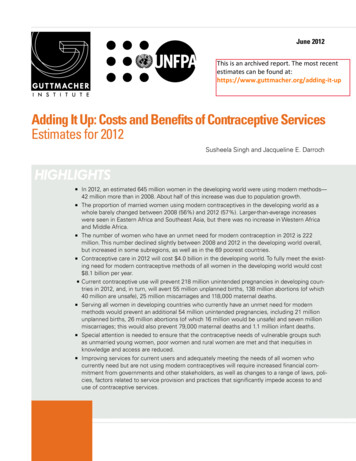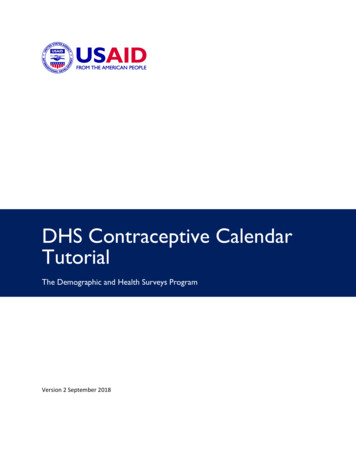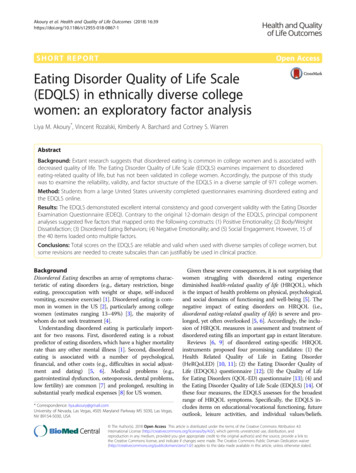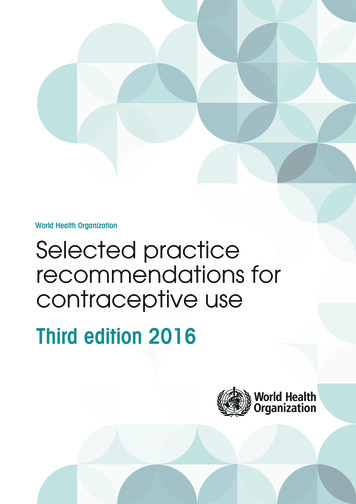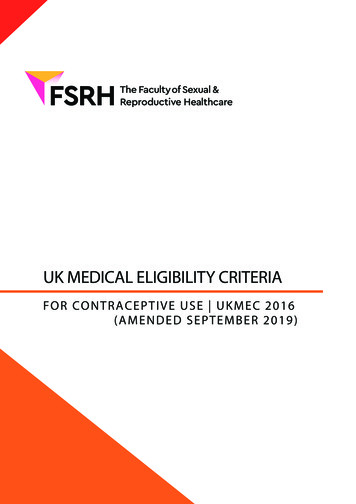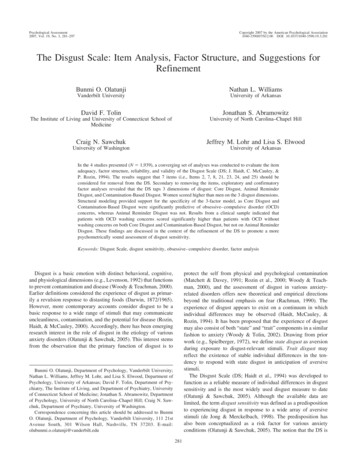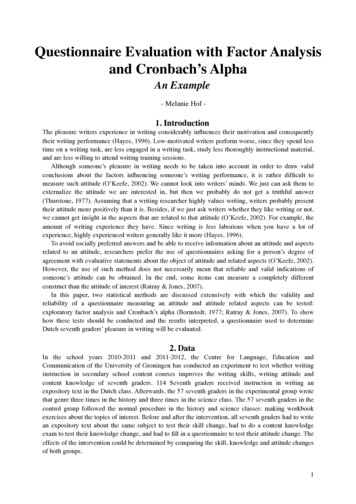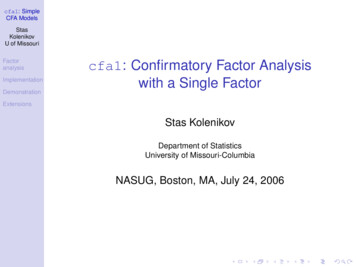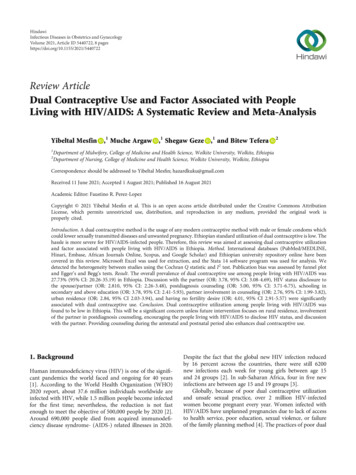
Transcription
HindawiInfectious Diseases in Obstetrics and GynecologyVolume 2021, Article ID 5440722, 8 pageshttps://doi.org/10.1155/2021/5440722Review ArticleDual Contraceptive Use and Factor Associated with PeopleLiving with HIV/AIDS: A Systematic Review and Meta-AnalysisYibeltal Mesfin ,1 Muche Argaw ,1 Shegaw Geze ,1 and Bitew Tefera122Department of Midwifery, College of Medicine and Health Science, Wolkite University, Wolkite, EthiopiaDepartment of Nursing, College of Medicine and Health Science, Wolkite University, Wolkite, EthiopiaCorrespondence should be addressed to Yibeltal Mesfin; hazardkuku@gmail.comReceived 11 June 2021; Accepted 1 August 2021; Published 16 August 2021Academic Editor: Faustino R. Perez-LopezCopyright 2021 Yibeltal Mesfin et al. This is an open access article distributed under the Creative Commons AttributionLicense, which permits unrestricted use, distribution, and reproduction in any medium, provided the original work isproperly cited.Introduction. A dual contraceptive method is the usage of any modern contraceptive method with male or female condoms whichcould lower sexually transmitted diseases and unwanted pregnancy. Ethiopian standard utilization of dual contraceptive is low. Thehassle is more severe for HIV/AIDS-infected people. Therefore, this review was aimed at assessing dual contraceptive utilizationand factor associated with people living with HIV/AIDS in Ethiopia. Method. International databases (PubMed/MEDLINE,Hinari, Embase, African Journals Online, Scopus, and Google Scholar) and Ethiopian university repository online have beencovered in this review. Microsoft Excel was used for extraction, and the Stata 14 software program was used for analysis. Wedetected the heterogeneity between studies using the Cochran Q statistic and I 2 test. Publication bias was assessed by funnel plotand Egger’s and Begg’s tests. Result. The overall prevalence of dual contraceptive use among people living with HIV/AIDS was27.73% (95% CI: 20.26-35.19) in Ethiopia. Discussion with the partner (OR: 3.78, 95% CI: 3.08-4.69), HIV status disclosure tothe spouse/partner (OR: 2.810, 95% CI: 2.26-3.48), postdiagnosis counseling (OR: 5.00, 95% CI: 3.71-6.75), schooling insecondary and above education (OR: 3.78, 95% CI: 2.41-5.93), partner involvement in counseling (OR: 2.76, 95% CI: 1.99-3.82),urban residence (OR: 2.84, 95% CI 2.03-3.94), and having no fertility desire (OR: 4.01, 95% CI 2.91-5.57) were significantlyassociated with dual contraceptive use. Conclusion. Dual contraceptive utilization among people living with HIV/AIDS wasfound to be low in Ethiopia. This will be a significant concern unless future intervention focuses on rural residence, involvementof the partner in postdiagnosis counseling, encouraging the people living with HIV/AIDS to disclose HIV status, and discussionwith the partner. Providing counseling during the antenatal and postnatal period also enhances dual contraceptive use.1. BackgroundHuman immunodeficiency virus (HIV) is one of the significant pandemics the world faced and ongoing for 40 years[1]. According to the World Health Organization (WHO)2020 report, about 37.6 million individuals worldwide areinfected with HIV, while 1.5 million people become infectedfor the first time; nevertheless, the reduction is not fastenough to meet the objective of 500,000 people by 2020 [2].Around 690,000 people died from acquired immunodeficiency disease syndrome- (AIDS-) related illnesses in 2020.Despite the fact that the global new HIV infection reducedby 16 percent across the countries, there were still 6200new infections each week for young girls between age 15and 24 groups [2]. In sub-Saharan Africa, four in five newinfections are between age 15 and 19 groups [3].Globally, because of poor dual contraceptive utilizationand unsafe sexual practice, over 2 million HIV-infectedwomen become pregnant every year. Women infected withHIV/AIDS have unplanned pregnancies due to lack of accessto health service, poor education, sexual violence, or failureof the family planning method [4]. The practices of poor dual
2contraceptive not only lead to unplanned pregnancies but alsoincrease epidemic of HIV/AIDS and other strains of sexuallytransmitted infections (STIs) [4–6]. Evidences also showedthat more than half of unintended pregnancy occurred amongadolescent mothers ending with unsafe abortion [7].A dual contraceptive method is the utilization of anymodern contraceptive method along with male or femalecondoms which can decrease sexually transmitted disease(STD) and unwanted pregnancy. Consistent and correct useof a condom alone is highly effective for preventing STIsand unwanted pregnancy. However, typical use of a malecondom as a contraception method may cause 15% ofunwanted pregnancy [8]. Other hormonal contraceptives likecombined oral contraceptive, injectable, implants, and intrauterine device protect pregnancy more but do not protectagainst HIV/AIDS and STIs [8, 9].Utilization of dual contraceptive among people livingwith HIV/AIDS (PLWHA) is low in many developing countries, including Ethiopia. Even though a national report wasnot conducted, studies in various regional states of Ethiopiashowed that dual contraceptive utilization among PLWHAis low. For example, in studies from Borena District, Northeast Ethiopia (19.4%), Gondar (13.2%), and Tigray (15.7%),PLWHA used dual contraceptive methods [10–12].Previous studies revealed that there are different enablingfactors for dual contraceptive utilization for PLWHA. Urbanresidence, disclosing HIV status to a partner, secondary andhigher educational level, partner involvement in counseling,postdiagnosis counseling about family planning, age of thewomen, discussion with the husband/partner, and having ahigher CD4 cell count were significant factors affecting theuse of dual contraceptive methods [11–13].Despite the fact that there are publications on the prevalence of dual contraceptive usage and factors associated withPLWHA in Ethiopia’s several regional states, there were nostudies conducted that indicate the overall level of dual contraceptive use among Ethiopian PLWHA nationally. Therefore, the aim of this review is to have a summary of pooledprevalence dual contraceptive use and factor associated withPLWHA in Ethiopia.2. Methods2.1. Study Design and Search Strategy. We searched studieswhich reported on the prevalence of dual contraceptive useand associated factor with PLWHA in Ethiopia. This systematic review included studies found in PubMed/MEDLINE,Hinari, Embase, African Journals Online, Scopus, and Google Scholar and Ethiopian university repository online. Allpublished articles as of May 10, 2021, were included in thereview. A search of the reference list of the already identifiedstudies to retrieve additional articles was done. The searchterms used were “PLWHA dual contraceptive use OR HIVpositive women contraceptive use during ART OR determinants dual contraceptive of use AND Ethiopia”. This was asystematic review and meta-analysis strictly adherent withthe Preferred Reporting Items for Systematic Reviews andMeta-Analyses (PRISMA) protocol.Infectious Diseases in Obstetrics and Gynecology2.2. Eligibility Criteria2.2.1. Inclusion Criteria. All cross-sectional (CS) publishedand unpublished studies which reported the prevalence andassociated factor with PLWHA in Ethiopia with English language research articles were included in the review. Studieswere searched from April 1 to 30, 2021.2.2.2. Exclusion Criteria. Articles whose full text and abstractwere unable to be accessed were excluded. Duplicated studieswere also checked and removed before the pooled processstarted.2.3. Data Extraction and Quality Assessment. All articles wereextracted and reviewed by two authors (MA and SG) independently with the standard Microsoft Excel spreadsheetform. Disagreement between these authors is handled by discussion with other two authors (YM and BT). The samplesize, year of publication, study design, name of authors,region where the study was conducted, prevalence of 95%CI, response rate, and odds ratio were extracted from theoriginal studies.2.3.1. Outcome Variable. The primary outcome variable of thissystematic review and meta-analysis was the prevalence ofdual contraceptive use among PLWHA. This was calculatedby the pooled prevalence of dual contraceptive use amongPLWHA.The other outcome variable of this review was factorsassociated with dual contraceptive use among PLWHA inany age group. Calculated by factors associated with dualcontraceptive use to each study log, an odds ratio was used.(1) Dual contraceptive use: dual contraceptive use is theutilization of a condom plus any other family planning method by PLWHA for the previous one month(2) Modern methods: the modern methods include sterilization, pills, intrauterine device, injectable, implants,and condom(3) Natural methods: the natural methods include temperature awareness, calendar, cervical mucus, lactational amenorrhoea, and coitus interruptus2.3.2. Data Processing and Analysis. The Microsoft Excelspreadsheet form was used for extraction, and the Stata 14software program was used for analysis. The overall pooledprevalence of dual contraceptive use was computed usingrandom effects meta-analysis. Publication bias was assessedby funnel plot through visual assessment. Egger’s and Begg’stests at 5% were also performed to detect publication bias.We detected the heterogeneity between studies using theCochran Q statistic and I 2 test. Subgroup analysis by regionand year was also calculated to compare dual contraceptiveutilization across regions of the country. The point prevalence with a 95% confidence interval (CI) was presented withforest plot format. The relation between the dual contraceptive and the associated factors was determined by theadjusted odds ratio (AOR).
Infectious Diseases in Obstetrics and Gynecology3. Result3.1. Description of the Included Study. We retrieved 145 studiesfrom the PubMed/MEDLINE, Hinari, Embase, African Journals Online, Scopus, and Google Scholar and Ethiopian university repository online research articles. After the duplicatedstudies were removed, 81 articles remained. Then, 70 articleswere excluded through the reading of their abstract and titles.Thus, 12 full-text articles were assessed for eligibility criteria,further yielding the exclusion of 1 article. Finally, the remaining11 articles were used to assess the pooled prevalence of dualcontraceptive use and its determinant (Figure 1).3.2. Characteristics of Identified Studies. In this review, 11cross-sectional studies were included. All studies were conducted after 2014. About 4386 study population was includedto estimate the pooled prevalence. Five regions were represented for this review. Three from the Amhara region, threefrom the Oromia region, two from the Southern Nations,Nationalities, and Peoples’ Region (SNNPR), two from theTigray region, and one study from the Benishangul-Gumuzregion in Ethiopia were included (Table 1).3.3. Prevalence of Dual Contraceptive Utilization. The lowestprevalence of dual contraceptive utilization was 13% observedin a study conducted in the Amhara region, and the highestprevalence was also 53.4% observed in a study conducted inthe Amhara region. The pooled national level of dual contraceptive utilization was 27.73% (95% CI: 20.26%, 35.19%)based on the random effects analysis (Figure 2).3.4. Subgroup Analysis. Subgroup analysis by region and yearwas also calculated to compare dual contraceptive utilizationacross regions of the country. Accordingly, the highest dualcontraceptive utilization was observed in BenishangulGumuz (40.94%, 95% CI: 36.14, 45.74) followed by the Oromia region (32.27%, 95% CI: 12.97, 51.58) and Tigray region(30.09%, 95% CI: 1.28, 58.91), whereas the lowest utilizationof dual contraceptive (20.26%, 95% CI: 10.99, 29.53) wasobserved in the Amhara region (Figure 3).3.5. Heterogeneity and Publication Bias. The I 2 (variation inES attributable to heterogeneity) test result showed that therewas high heterogeneity with I 2 97:2, at p value 0.0001.We also assessed the presence of publication bias amongstudies included in the review. The funnel plot showed thatthere was an asymmetrical distribution of the included studies through visual inspection, which indicates that there waspotential publication bias (Figure 4). However, the Eggerregression test (p 0:032) and Begg rank correlation statistics (p 0:161) showed that there was no evidence of potential publication bias.3.6. Sensitivity Analysis. We conducted a sensitivity analysisusing a random effects model. Hence, the results showed thatno single study influenced the overall pooled proportion ofdual contraceptive utilization among PLWHA (Figure 5).3.7. Factors Associated with Dual Contraceptive Utilization.The current review identified different factors associated withdual contraceptive utilization for PLWHA in Ethiopia. Sig-3nificantly associated factors were residence, disclosure, discussion with the partner about family planning, counselingabout family planning, positive partner, fertility desire, andeducational status.The PLWHA residence was significantly associated withdual contraceptive. Using the studies included in the groupof meta-analysis, PLWHA who live in urban areas were2.84 times more likely to use dual contraceptive (AOR:2.84, 95% CI 2.03, 3.94) than those living in rural residence.In this review, PLWHA who have discussed with theirpartner were 3.78 times more likely to use contraceptives(AOR: 3.78, 95% CI: 3.08-4.69) than those who have notdiscussed with their partner.Other significant factors associated with dual contraceptive utilization were disclosure of HIV status with the partner. Dual contraceptive use was more likely on PLWHAwho disclose their HIV status to their partner than on theircounterpart (AOR: 2.810, 95% CI: 2.26-3.48).Those PLWHA who counseled about family planningever were 5 times more likely to use dual contraceptives ascompared with those not getting any family planningcounseling (AOR: 5.00, 95% CI: 3.71-6.75). Similarly, individuals whose partner is involved in counseling were 2.76times more likely to utilize dual contraceptives as comparedwith their counterpart (AOR: 2.76, 95% CI: 1.99-3.82).Educational status is also a novel factor affecting dualcontraceptive use. PLWHA who finished secondary andabove education were 3.78 times more likely to use dual contraceptives than their counterpart (AOR: 3.78, 95% CI: 2.415.93). Additionally, PLWHA who have no desire were 4.01times more likely to use dual contraceptive than those havingthe desire in the future (OR 4:01, 95% CI 2.91, 5.57).4. DiscussionDual contraceptive uses among PLWHA have an enormousbenefit to controlling unwanted pregnancies, decreasingunsafe abortions, and reducing HIV-positive deliveries. Sothis review was aimed at assessing dual contraceptive utilization and factor associated with people living with HIV/AIDSin Ethiopia. In this meta-analysis, the pooled prevalence ofdual contraceptive use among PLWHA in Ethiopia was27.73% (95% CI: 20.26%, 35.19%). Despite the fact that nocomparable meta-analysis study on this specific topic hasbeen conducted in the area, the overall prevalence of dualcontraceptive use by PLWHA is analogous to studies conducted in southeast Nigeria (27.7%) [14]; Soweto, SouthAfrica (33%) [15]; Brazil (28%) [16]; and India (23%) [17].This finding is higher than studies conducted in Uganda(3.5%) [18] and Zambia (17.7%) [19]. But it is lower thanstudies conducted in Bungoma County, Kenya (38%.5)[20]; Nigeria (45%) [21]; and United States of America(47%) [22]. This difference might be because of regional variation and variation in guidelines of reproductive health andhealth policy of the country.This study showed that HIV-positive women who wereliving in urban areas were more likely to use dual contraceptive methods as compared to those living in rural areas. Thisis consistent with the finding from Malawi and Togo [23, 24].
Infectious Diseases in Obstetrics and GynecologyDuplication removed(n 64)Article identified throughdatabase searching (n 145)EligibilityTotal number of articles screened bytitle and abstract (n 81)Total number of articles screened by fullarticle (n 12)IncludedScreeningIdentification4Final number of articles included inthe review (n 11)Total number of articles removedby title (n 70)Total number of articles removedafter review full article andabstract (n 1)Figure 1: Flow diagram of study selection for systematic and meta-analysis of dual contraceptive use in Ethiopia.Table 1: Descriptive summary of 11 studies included in the meta-analysis of dual contraceptive use in Ethiopia.Name of authorAssefa AlemayehuDemissie et al.Gebrehiwot et al.Abay et al.Dereje BeyissiaHalefom KalayuAmare et al.Tilahun BeyeneErashi et al.Reta et al.Tilahun et al.Publication yearRegionStudy designSample sizeResponse 298.895.998.7898.2597.7The explanation for this might be because of the variation inaccessing information and services related to this area. Theurban women more easily accessed important informationand services related to dual contraceptive utilization throughdifferent sources like social media and also from their dailysocial interpersonal relationships.In this review, PLWHA who have discussed with theirpartner were 3.78 times more likely to use dual contraceptives
Infectious Diseases in Obstetrics and Gynecology5%PublicationAuthoryearES (95% Cl)weightAssefa Alemayehu201840.94 (36.14, 45.74)9.03Demissie et al.201522.69 (18.34, 27.03)9.10Gebrehiwot et al201715.41 (11.52, 19.30)9.15Abay et al.202028.77 (25.03, 32.51)9.17Dereje Beyissia201953.39 (48.08, 58.70)8.96Halefom Kalayu201744.81 (40.53, 49.08)9.10Amare et al.202119.18 (15.41, 22.96)9.16Tilahun Beyene201927.14 (21.82, 32.45)8.96Erashi et al.201519.51 (14.56, 24.46)9.01Reta et al201913.02 (10.39, 15.64)9.28Tilahun et al202120.90 (16.38, 25.42)9.0727.73 (20.26, 35.19)100.00Overall (I2-squared 97.2%, p 0.001)NOTE: weights are from random effects analysis.25.75.501Figure 2: Forest plot in pooled prevalence of dual contraceptive use in Ethiopia.(AOR: 3.78, 95% CI: 3.08-4.69) than those who have not discussed with their partner. This was supported by studies donein Tanzania, Zambia, and Malawi [17, 25, 26]. This is clearthat an open communication between couples about sexualand reproductive issue helps to improve contraceptive use. Itimplies that the need to introduce open discussion betweencouples on sexual and reproductive issue helps not only toincrease dual contraceptive use but also to improve adherenceon ART and PMTCT and minimize loss of follow-up forPLWHA [27].This meta-analysis showed that PLWHA who disclosetheir HIV statuses to their spouse/partner were found to havesignificantly increased utilization of dual contraceptives. Thisfinding was supported by studies done in Kenya, Zimbabwe,and Ghana [20, 28, 29]. It is because disclosure facilitatingopen discussion between partners helps them to mutuallyaccept the importance of dual contraceptive use.Educational status was also a novel factor affecting dualcontraceptive use. People living with HIV/AIDS who finished secondary and above education were 3.78 times morelikely to use dual contraceptives than their counterpart. Similar report supports this systematic review from Brazil andUganda [30, 31]. This can be explained by the fact that educated women have more awareness of dual contraceptive onprevention of HIV/AIDS, unwanted pregnancy, and sexuallytransmitted disease. Therefore, educating PLWHA is aprominent factor to increase dual contraception use.PLWHA who had no fertility desire were more likely touse dual contraceptive as compared to their counterpart. Thisfinding is in line with studies from South Africa and Kenya[15, 32]. This may be because couples living with HIV/AIDSwho did not want to have a child in the future were morelikely use dual contraceptive to protect unwanted pregnancyand STI transmission.This meta-analysis indicated that PLWHA who receivedpostdiagnosis counseling on family planning were morelikely to utilize dual contraceptive methods. The finding issupported by studies from India and Tanzania [17, 25]. Thismight be explained by the fact that PLWHA have been counseled during their follow-up by a healthcare provider to getmore knowledge about reproductive health. Having adequateknowledge about family planning leads to the use of moredual contraceptive to minimize HIV transmission and unintended pregnancy.Furthermore, the meta-analysis identified that dual contraceptive use was higher in partner involvement in counseling about family planning. The finding was supported by astudy from India [17]. It is found in this finding that involvement of the partner in counseling helps the couple for opendiscussion for their sexual and reproductive health serviceutilization.Finally, this systematic review and meta-analysis haslimitations. All studies included in this study were cross-sectional, and establishing a cause and effect is imposable due to
6Infectious Diseases in Obstetrics and GynecologyAuthorPublicationyearBesnshagul gomezASSEFA et al.2018Subtotal (I-squared .%, p .).OromiaDemmssie et al.2015Dereje B., et al.2019Tilahun et al.2021Subtotal (I2-squared 98.0%, p 0.001).TigrayGebrehiwot et al.2017Halefom Kalayu2014Subtotal (I2-squared 99.0%, p 0.001).AmharaAbay et al.2020Gashaw2021Reta et al.2019Subtotal (I2-squared 95.6%, p 0.001).SNNPRTilahun2019Meseret W Mariam2015Subtotal (I2-squared 76.4%, p 0.040).Overall (I2-squared 97.2%, p 0.001)ES (95% Cl)%weight40.94 (36.14, 45.74)40.94 (36.14, 45.74)9.039.0322.69 (18.34, 27.03)53.39 (48.08, 58.70)20.90 (16.38, 25.42)32.27 (12.97, 51.58)9.108.969.0727.1315.41 (11.52, 19.30)44.81 (40.53, 49.08)30.09 (1.28, 58.91)9.159.1018.2628.77 (25.03, 32.51)19.18 (15.41, 22.96)13.02 (10.39, 15.64)20.26 (10.99, 29.53)9.179.169.2827.6127.14 (21.82, 32.45)19.51 (14.56, 24.46)23.26 (15.79, 30.73)8.969.0117.9727.73 (20.26, 35.19)100.00Note: weights are from random effects analysis.25.75.501Figure 3: Forest plot showing the subgroup analysis of dual contraceptive in Ethiopia by region.Funnel plot with pseudo 95% confidence limitss.e. of prevalence0123102030Prevalence4050Figure 4: Funnel plot depicting publication bias of studies reporting the dual contraceptive use in Ethiopia.
Infectious Diseases in Obstetrics and Gynecology7Meta-analysis estimates, given named study is omittedAssefa Alemayehu (2018)Demissie et al. (2015)Gebrehiwot et al. (2017)Abay et al. (2020)Dereje Beyissia (2019)Halefom Kalayu (2017)Amare et al. (2021)Tilahun Beyene (2019)Erashi et al. (2015)Reta et al. (2019)Tilahun et al. (2021)5.826.5422.3076.07103.79Lower Cl limitEstimateUpper Cl limitFigure 5: Sensitivity analysis of the prevalence of dual contraceptive use in Ethiopia.study design limitation. Additionally, the studies were fromfive regions only which may restrict the representativenessof the finding.5. ConclusionThe overall utilization of the dual contraceptive method is low.Urban residence, disclosure of HIV status, discussion with thepartner about family planning, counseling about family planning, partner involvement in counseling, fertility desire, andeducational status were factors affecting utilization of dualcontraceptive for PLWHA. Therefore, based on the studyfindings, husband involvement and providing counselingabout contraceptive methods for PLWHA should be encouraged, and there is a need for an intensified effort to improvereproductive health service utilization. Healthcare providersin charge of HIV caregiving must also integrate family planning service counseling in HIV care during follow-up NPR:STIs:WHO:Adjusted odds ratioAcquired immunodeficiency disease syndromeCross-sectionalConfidence intervalOdds ratioHuman immunodeficiency virusPeople living with HIV/AIDSSouthern Nations, Nationalities, and Peoples’RegionSexually transmitted infectionsWorld Health Organization.Data AvailabilityFull datasets and other materials about this study could beobtained from the corresponding author upon reasonablerequest.Conflicts of InterestThe authors declare that there is no financial and nonfinancialconflict of interest regarding the publication of this paper.Authors’ ContributionsAll authors contributed to data analysis and drafting or revising the article, gave the final approval of the version to bepublished, and agreed to be accountable for all of the work.References[1] B. X. Tran, H. T. Phan, C. A. Latkin et al., “Understandingglobal HIV stigma and discrimination: are contextual factorssufficiently studied? (GAPRESEARCH),” International journal of environmental research and public health, vol. 16,no. 11, p. 1899, 2019.[2] Global HIV Statistics, UNAIDS, 2021, https://www.unaids.org/sites/default/files/media asset/UNAIDS FactSheet en.pdf.[3] A. B. Kharsany and Q. A. Karim, “HIV infection and AIDS insub-Saharan Africa: current status, challenges and opportunities,” The open AIDS journal, vol. 10, no. 1, pp. 34–48, 2016.[4] D. Josefson, “Unsafe sexual practices are common, say USstudies,” BMJ, vol. 327, no. 7405, pp. 10-d–10-0, 2003.[5] J. R. Willard Cates and M. J. Steiner, “Dual protection againstunintended pregnancy and sexually transmitted infections:
nfectious Diseases in Obstetrics and Gynecologywhat is the best contraceptive approach?,” Sexually transmitteddiseases, vol. 29, no. 3, pp. 168–174, 2002.M. C. SI, R. Buzdugan, L. J. Ralph et al., “Unmet need forfamily planning, contraceptive failure, and unintended pregnancy among HIV-infected and HIV-uninfected women inZimbabwe,” PLoS One, vol. 9, no. 8, article e105320, 2014.A. Singh, A. Singh, and B. Mahapatra, “The consequences ofunintended pregnancy for maternal and child health in ruralIndia: evidence from prospective data,” Maternal and childhealth journal, vol. 17, no. 3, pp. 493–500, 2013.J. Trussell and K. Guthrie, “Choosing a contraceptive: efficacy,safety, and personal considerations,” in Contraceptive Technology, R. A. Hatcher, J. Trussell, A. L. Nelson, W. Cates, F. H.Stewart, and D. Kowal, Eds., pp. 19–47, Ardent Media, Inc,New York (NY), 19th edition, 2007.W. CATES, M. STEINER, and E. Raymond, “Dual vs. duel(ing) protection against unintended pregnancy and sexuallytransmitted infections: what is that best contraceptiveapproach? Research Triangle Park,” in USAID Open Forumon Condom Promotion and Dual Protection, Family HealthInternational, Washington, DC, 2000.N. C. Gashaw Amare and A. M. Mekonen, “Dual contraceptiveuse and associated factors among reproductive age group onantiretroviral therapy in Borena District, Northeast Ethiopia:a cross-sectional study,” HIV/AIDS (Auckland, NZ), vol. 13,p. 107, 2021.M. M. Reta, G. A. Tessema, and G. Shiferaw, “Prevalence ofdual contraceptive use and associated factors among HIV positive women at University of Gondar Hospital, NorthwestEthiopia,” BMC research notes, vol. 12, no. 1, pp. 1–7, 2019.S. W. Gebrehiwot, G. A. Azeze, C. C. Robles, and Y. M. Adinew, “Utilization of dual contraception method among reproductive age women on antiretroviral therapy in selected publichospitals of Northern Ethiopia,” Reproductive health, vol. 14,no. 1, pp. 1–9, 2017.M. W. Mariam, F. Yadassa, and T. Tema, “Dual-contraceptivemethod utilization and associated factors among HIV positivewomen attending art clinic in Gebretsadik Shawo Hospital,SNNPR, South West Ethiopia,” Women’s Health Care, vol. 4,no. 6, 2015.L. O. Lawani, A. K. Onyebuchi, and C. A. Iyoke, “Dual methoduse for protection of pregnancy and disease prevention amongHIV-infected women in South East Nigeria,” BMC women'shealth, vol. 14, no. 1, p. 39, 2014.A. Kaida, F. Laher, S. A. Strathdee et al., “Contraceptive use andmethod preference among women in Soweto, South Africa: theinfluence of expanding access to HIV care and treatment services,” PLoS One, vol. 5, no. 11, article e13868, 2010.J. Magalhães, E. Amaral, P. C. Giraldo, and J. A. Simoes, “HIVinfection in women: impact on contraception,” Contraception,vol. 66, no. 2, pp. 87–91, 2002.V. Chakrapani, T. Kershaw, M. Shunmugam, P. A. Newman, D. H. Cornman, and R. Dubrow, “Prevalence of andbarriers to dual-contraceptive methods use among marriedmen and women living with HIV in India,” Infectious diseases in obstetrics and gynecology, vol. 2011, Article ID376432, 8 pages, 2011.J. Heys, W. Kipp, G. S. Jhangri, A. Alibhai, and T. Rubaale,“Fertility desires and infection with the HIV: results from asurvey in rural Uganda,” AIDS (London, England), vol. 23,Suppl 1, pp. S37–S45, 2009.[19] C. J. Chibwesha, M. S. Li, C. K. Matoba et al., “Modern contraceptive and dual method use among HIV-infected women inLusaka, Zambia,” Infectious diseases in obstetrics and gynecology, vol. 2011, 8 pages, 2011.[20] A. M. Mulongo, R. W. Lihana, J. Githuku, Z. Gura, andS. Karanja, “Factors associated with uptake of dual contraception among HIV-infected women in Bungoma County, Kenya:a cross-sectional study,” The Pan African Medical Journal,vol. 28, Suppl 1, p. 2, 2017.[21] L. Adeokun, J. E. Mantell, E. Weiss et al., “Promoting dual protection in family planning clinics in Ibadan, Nigeria,” InternationalFamily Planning Perspectives, vol. 28, no. 2, pp. 87–95, 2002.[22] T. E. Wilson, L. J. Koenig, E. Walter, I. Fernandez, andK. Ethier, “Dual contraceptive method use for pregnancy anddisease prevention among HIV-infected and HIV-uninfectedwomen: the importance of an event-level focus for promotingsafer sexual behaviors,” Sexually transmitted diseases, vol. 30,no. 11, pp. 809–812, 2003.[23] D. Habte and J. Namasasu, “Family planning use amongwomen living with HIV: knowing HIV positive status helpsresults from a national
in a study conducted in the Amhara region, and the highest prevalence was also 53.4% observed in a study conducted in the Amhara region. The pooled national level of dual contra-ceptive utilization was 27.73% (95% CI: 20.26%, 35.19%) based on the random effects analysis (Figure 2). 3.4. Subgroup Analysis. Subgroup analysis byregionand year

